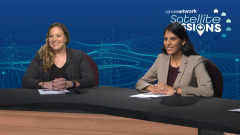
Dosing and Sequencing Bispecifics and CAR T-Cell Therapies in R/R MM
Key opinion leaders share comprehensive insight on optimal dosing and sequencing strategies in patients with relapsed/refractory multiple myeloma.
Episodes in this series

Transcript:
Krina K. Patel, MD, MSc: In terms of the bispecifics, I want to come back to the GPRC5D [G protein–coupled receptor, class C, group 5, member D] too because now we have so many ways to get to BCMA [B-cell maturation antigen]. We don’t know the mechanism of resistance yet for patients who relapse. We think that with bispecifics, it’s this continued pressure that leads to BCMA loss more so than we do in CAR [chimeric antigen receptor]-T compared to the CD19 CAR-T where I know the CD19 loss is much higher. If someone’s on a bispecific, I guess the first thing would be to have a fixed dose or not coming back to that rather than continuous dosing? What are your thoughts about that?
Melody R. Becnel, MD: I think fixed dose would be amazing. I think every patient would agree with that as well. I do think that as time goes on we will have the data to prove that it’s feasible.
Krina K. Patel, MD, MSc: We’re already doing it. Then, when someone is relapsing, I think it opens up more options because if you’re relapsing on to me a continuous BCMA therapy I’m automatically going to switch targets versus if you’re not. Then we have other targets too, but we could still go back to a different BCMA therapy. What are your thoughts about GPRC5D if you have any?
Melody R. Becnel, MD: I have thoughts from trials.
Krina K. Patel, MD, MSc: We haven’t had those trials.
Melody R. Becnel, MD: We haven’t had those trials, but from a toxicity perspective, it’s just a slightly different toxicity perspective. More of like a nail dermatological type perspective. I’d be interested to start administering these because it seems like the responses are great, overall well-tolerated, but again, I love the option of having another target, especially for people who’ve kind of exhausted their BCMA targets already.
Krina K. Patel, MD, MSc: I agree. I think that the infection risk may be made a little lower, which is great compared to some of the BCMA data. Again, having a different target is fantastic and I think it’s just learning how to mitigate some of these other side effects that people are having because of the expression of GPRC5D. Any thoughts on the different targets and sequencing? Why can’t we just do GPRC5D first and then BCMA?
Tejo N. Musunuru, MD: Sure. One of the issues with them is the toxicities. In the satellite locations, firstly, getting the drug or dealing with the CRS [cytokine release syndrome] in those is 1 step. The problem with long-term toxicities, like the ocular or the ophthalmic toxicities of the BCMA targets, like the ADCs [antibody-drug conjugates], is we can’t just send them to a community ophthalmologist and expect them to understand all the risks that are associated and the infectious risks, too. We deal with the infectious doctors that are nearby and they may not always understand the risks that are associated or the medication interactions with these different toxicities. So that would be the way to kind of think about the sequencing from my perspective.
Melody R. Becnel, MD: To my knowledge, there hasn’t really been many studies looking. It’s obviously all new and we haven’t had lots of long-term studies. If I can get a patient on a bispecific, especially on a trial, I personally don’t care which target I’m going after first. If it’s GPRC[5D] or something else, I don’t care which target is first because we have the option for the other one later. So the responses are great either way.
Tejo N. Musunuru, MD: Have you had any experience with having the sequencing?
Krina K. Patel, MD, MSc: Yeah. We have a paper that’s submitted right now in terms of BCMA sequencing prior to CAR-T and there’s a few papers with cilta-cel [ciltacabtagene autoleucel]. I think it was CARTITUDE-2 [NCT04133636] cohort C. So when bispecifics are given before CAR-T, the response rates of the CAR-T dropped, and with cilta-cel [ciltacabtagene autoleucel], it dropped from 97% on CARTITUDE-1 [NCT03548207] to about 60% if they’ve had a prior BCMA bispecific. The PFS [progression-free survival] is what’s low. It ends up being like 6 months. I think for cilta-cel [ciltacabtagene autoleucel] versus when you haven’t had a prior bispecific BCMA, they haven’t hit their 2-year median progression-free survival yet, which is one of the best things we’ve ever seen in myeloma. Same thing with ide-cel [idecabtagene vicleucel]. If you get a prior BCMA bispecific, your response rates might still be OK. It was still like 80%. But the PFS was 3 months. We think that it’s the BCMA expression, but also the fact that T cells are exhausted. How do you make a CAR out of a completely exhausted T cell? So multiple reasons why that probably doesn’t work now post. There was the teclistamab [Tecvayli] study that showed if you got a prior BCMA therapy, and then got the bispecific, you still had great response. It was maybe 5% to 10% lower than without, but we don’t have the PFS data yet on that one. To me, scientifically, it makes sense to go in that order. But again, it comes back to access, and are we going to have access for all these things?
I think having GPRC5D or FcRH5 [Fc receptor-homolog 5] to be able to play, is going to be crazy trying to look at this retrospectively for these patients and what happens. But I think for that reason, having more targets, for me, I’m excited that maybe we can put them all together in the future and finally get that plateau that Ahmed gets and finally get it for myeloma. Then, coming back to the logistics a little bit, the step-up dosing for all the different drugs is important to consider. For teclistamab, it’s a small dose and then 2 to 3 days later, you get the still small dose 0.6, but it’s a little bit bigger and then you get the full first dose. You kind of mentioned that most patients are probably getting that CRS with that first full dose, but there have been a couple even with the second full dose. What did you do for that patient? Bring them into the hospital afterwards when they got a fever again?
Melody R. Becnel, MD: Well, this patient I was actually on the inpatient service at the time. So because she had a severe reaction for the first dose, the trial team had actually recommended to admit her for that second dose, so conveniently she was already there.
Krina K. Patel, MD, MSc: Perfect. I’ve had patients. As of right now, we admit everybody that’s had a fever, especially if they’re neutropenic. But I think we’re trying to figure out how to do this whole thing with outpatients so that we can treat without toci [tocilizumab] or anything. Maybe that second dose of dex [dexamethasone] or something would help.
Transcript edited for clarity.
Newsletter
Stay up to date on recent advances in the multidisciplinary approach to cancer.






















































































